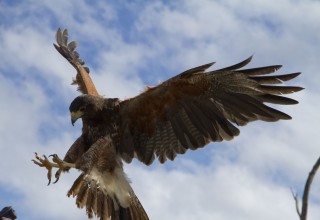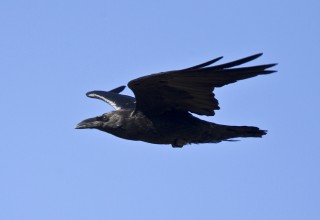Popular Raptor Free Flight Presentations Begin October 17 at the Desert Museum

Tucson, AZ, October 5, 2015 (Newswire.com) - The soaring birds of prey in the Arizona-Sonora Desert Museum’s most popular presentation, Raptor Free Flight, return to the skies on October 17, with two demonstrations daily at 10a.m. and 2p.m. through March 27, 2016. This one-of-a-kind presentation differs from other shows of its kind in that the birds are flown in the open desert as opposed to an amphitheater and the birds fly completely untethered. Plus, these presentations feature the only raptors in the world that hunt as a family using strategy, like wolves.
Guests watch from the flight zone experiencing the soft sweep of air from the brush of the birds; feathers as the raptors often fly close over the viewing area. The presentation’s narrator explains the physical attributes, flight characteristics, hunting patterns and habitats of each species as guests watch the birds in action.
"Raptors are fascinating because of the intelligence they exhibit in planning their hunt and the precision in which they execute their capture," says Amanda Timmerman, Collections Specialist, who heads the Raptor Free Flight team.
Rosemary Prawdzik, Director of Marketing & Sales
“Raptors are fascinating because of the intelligence they exhibit in planning their hunt and the precision in which they execute their capture,” says Amanda Timmerman, Collections Specialist, who heads the Raptor Free Flight team.
Raptors are highly specialized birds that capture prey to eat. Distinctive physical features work to maximize the birds’ hunting skills: Acute vision and hearing, estimated to be ten times greater than a human; a strong hard hooked beak; and powerful, sharp talons. Birds in the raptor family include Eagles, Hawks, Kites, Falcons, and Owls.
Like all animals at the Desert Museum, the raptors in the presentation inhabit the Sonoran Desert region. They include Ferruginous Hawks, Gray Hawks, Prairie Falcons, Red-tailed Hawks, Chihuahuan Ravens (not classified at raptors) and the nocturnal hunters -- Great Horned Owls and Barn Owls. Each of these hunters has distinguishing features.
Built for speed and rapid acceleration, the Peregrine Falcon is the fastest raptor in the presentation as well as being the fastest animal on earth. Diving at more than 200 mph, the Falcon experiences up to 27 G’s in its dive. A human loses consciousness at a G force of 5. The Peregrine almost exclusively hunts other birds, often capturing them in mid-air.
Another raptor exhibits a trait found only in its species--the Harris’s Hawk. Often called “hawks of the sky”, these raptors, working as a group, create and implement strategies for their pursuit of prey. Females are dominant in the hierarchy.
“Raptor Free Flight is an extraordinary experience and the perfect opportunity to take excellent photos of these birds in a natural setting,” says Craig Ivanyi, Executive Director of the Museum.
The up-close nature of the presentation is ideal for photographing the birds in the air and at rest. The perfect chance to capture aerial shots is as the raptors glide or dive toward the audience. The birds land just a few feet from the observation area for a close up look at them as they perch.
Each presentation features a different group of birds, although the exact composition of each presentation varies due to weather and bird behavior. Guests should arrive 20 minutes prior to each show to allow time to enter the Museum and walk to the observation area. Raptor Free Flight presentations are free with regular paid Museum admission.
###
Focused on the Sonoran Desert region of the United States and Mexico, the Arizona-Sonora Desert Museum is largely an outdoor experience and includes a zoo, botanical garden, art gallery, natural history museum and aquarium. Set on 98 acres, the Museum is home to 230 animal species, 56,000 individual plant specimens, two miles of walking paths and one of the world’s most comprehensive regional mineral collections. The Desert Museum is actively involved in education, conservation, and research programs to help preserve the Sonoran Desert region.



